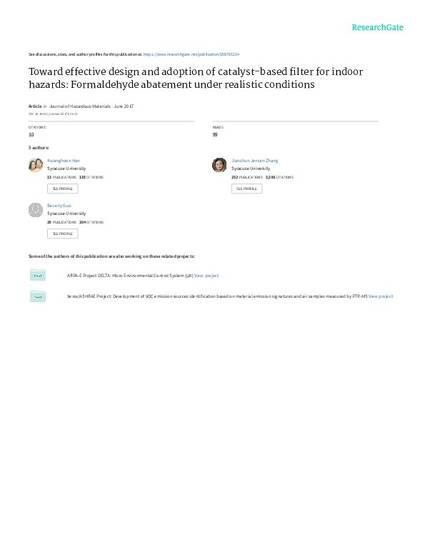
Article
Toward effective design and adoption of catalyst-based filter for indoor hazards: Formaldehyde abatement under realistic conditions
Journal of Hazardous Materials
(2017)
Abstract
Catalytic oxidation at ambient temperature has drawn wide attention as a new promising method of air cleaning, converting hazardous materials into non-hazardous ones. However, limited information is available regarding catalytic filter performance/characteristics under real operating conditions, especially on service efficiency and byproducts. Also, no practical scale-up method/evidence for filter performance evaluation is currently available to scale-up laboratory results to real application conditions. These limitations and knowledge gaps prevent building owners/designers from adopting this new promising technique in their commercial/industrial applications. The present study conducted experiments from small-scale to full-scale chamber tests which challenged a developed catalytic filter under realistic conditions. Formaldehyde was selected for approach demonstration due to its indoor ubiquitousness and criticality for human health even at low-levels. Results showed that the competition level for reaction sites in filter media had a crucial role in the performance for formaldehyde abatement, a high initial (77%; under no competing pollutants) to a typical stable level (23–32%), depending on the coexistence of other pollutants and moisture in the air, that the employment of this type of filter might generate byproducts (opposite to previous literature reports), and that small-scale column tests represented a good indication for large-scale filter performance as a practical screening method.
Keywords
- Formaldehyde abatement,
- Manganese oxide catalyst,
- Full-scale chamber test,
- Room-temperature oxidation,
- PTR-MS
Disciplines
Publication Date
June 5, 2017
DOI
https://doi.org/10.1016/j.jhazmat.2017.02.021
Citation Information
KwangHoon Han. "Toward effective design and adoption of catalyst-based filter for indoor hazards: Formaldehyde abatement under realistic conditions" Journal of Hazardous Materials Vol. 331 (2017) p. 161 - 170 Available at: http://works.bepress.com/shimsong/10/
